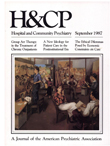A Community Survey of Self-Injurious Behavior Among Developmentally Disabled Children and Adolescents
Abstract
The extent, nature, and treatment of self-injurious behavior was surveyed among 2,663 developmentally disabled children and adolescents in a large metropolitan school district during the 1984-85 school year. Sixty-nine, or 2.6 percent, of the students exhibited at least one type of self-injurious behavior during the preceding 12 months; 59 percent of these students were males and 41 percent were females. Most of the self-injurious students were either severely or profoundly retarded, and their mean age was 10.2 years. Although almost three-quarters of the students exhibited self-injurious behavior at least daily, only a third were engaged in formal treatment programs for the problem. More than half (53.6 percent) had been restrained during the preceding 12 months for such behavior, and 8.7 percent had received psychotropic medications. The authors believe that the development of effective treatment strategies for self-injurious individuals living in the community may help them avoid institutionalization.
Access content
To read the fulltext, please use one of the options below to sign in or purchase access.- Personal login
- Institutional Login
- Sign in via OpenAthens
- Register for access
-
Please login/register if you wish to pair your device and check access availability.
Not a subscriber?
PsychiatryOnline subscription options offer access to the DSM-5 library, books, journals, CME, and patient resources. This all-in-one virtual library provides psychiatrists and mental health professionals with key resources for diagnosis, treatment, research, and professional development.
Need more help? PsychiatryOnline Customer Service may be reached by emailing [email protected] or by calling 800-368-5777 (in the U.S.) or 703-907-7322 (outside the U.S.).



